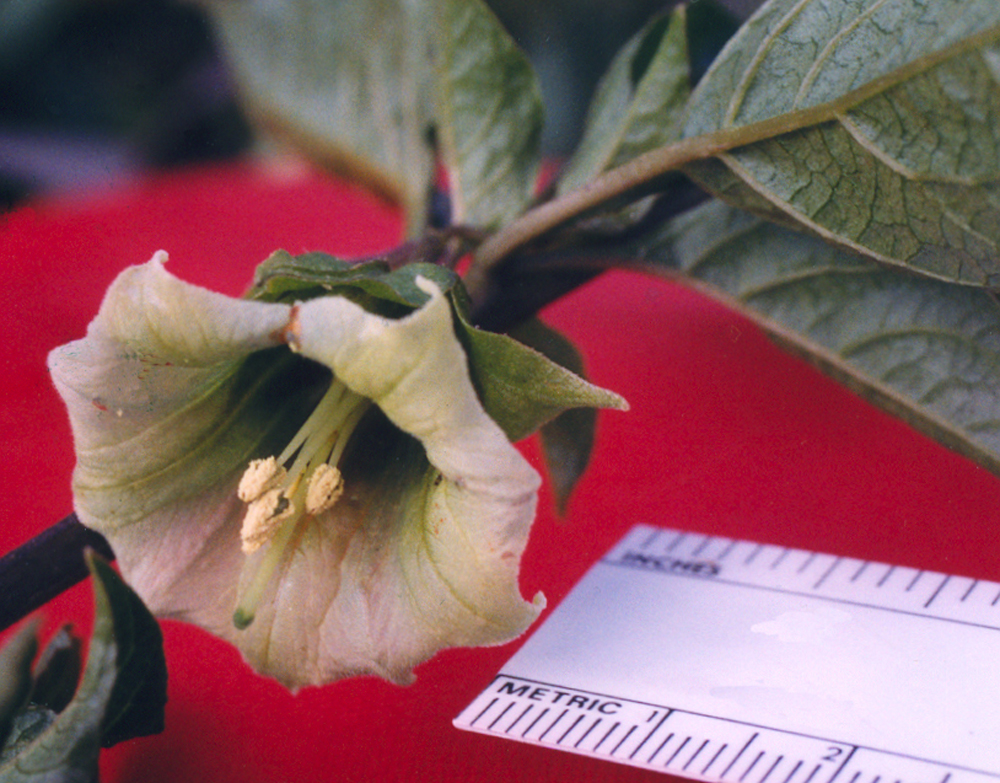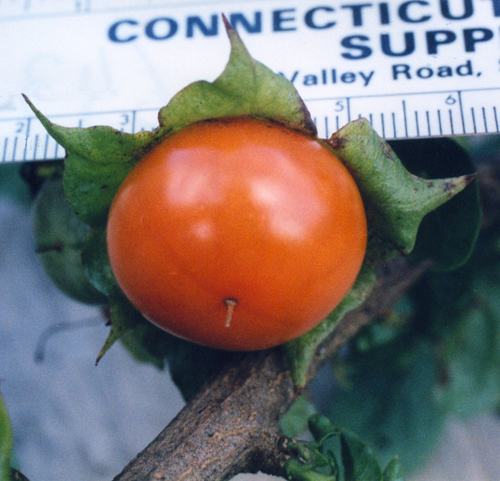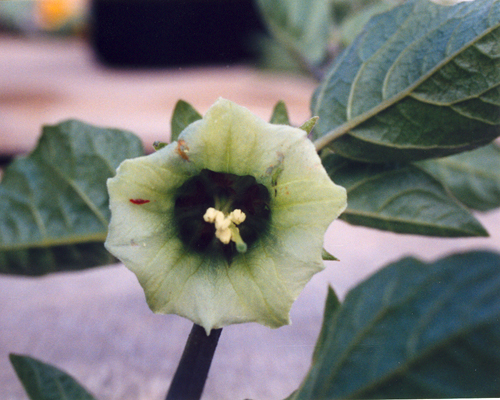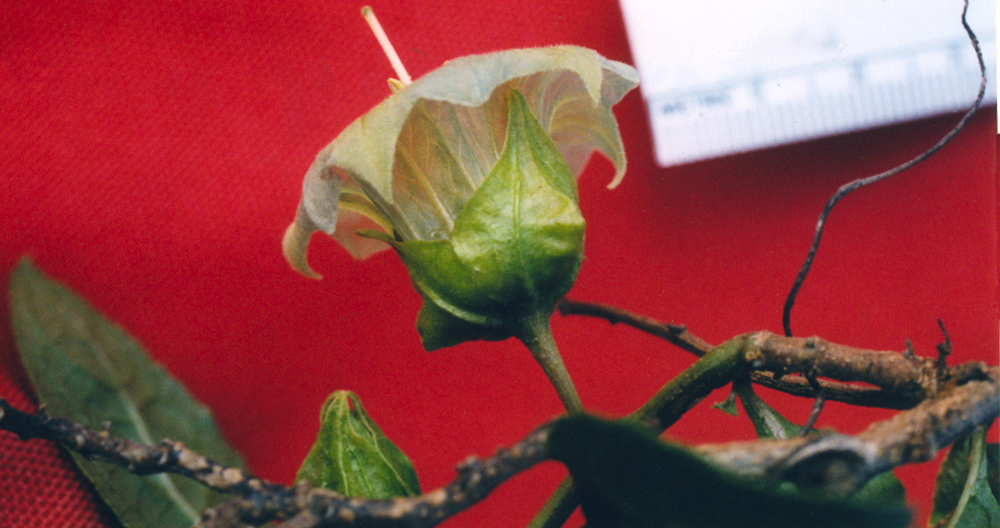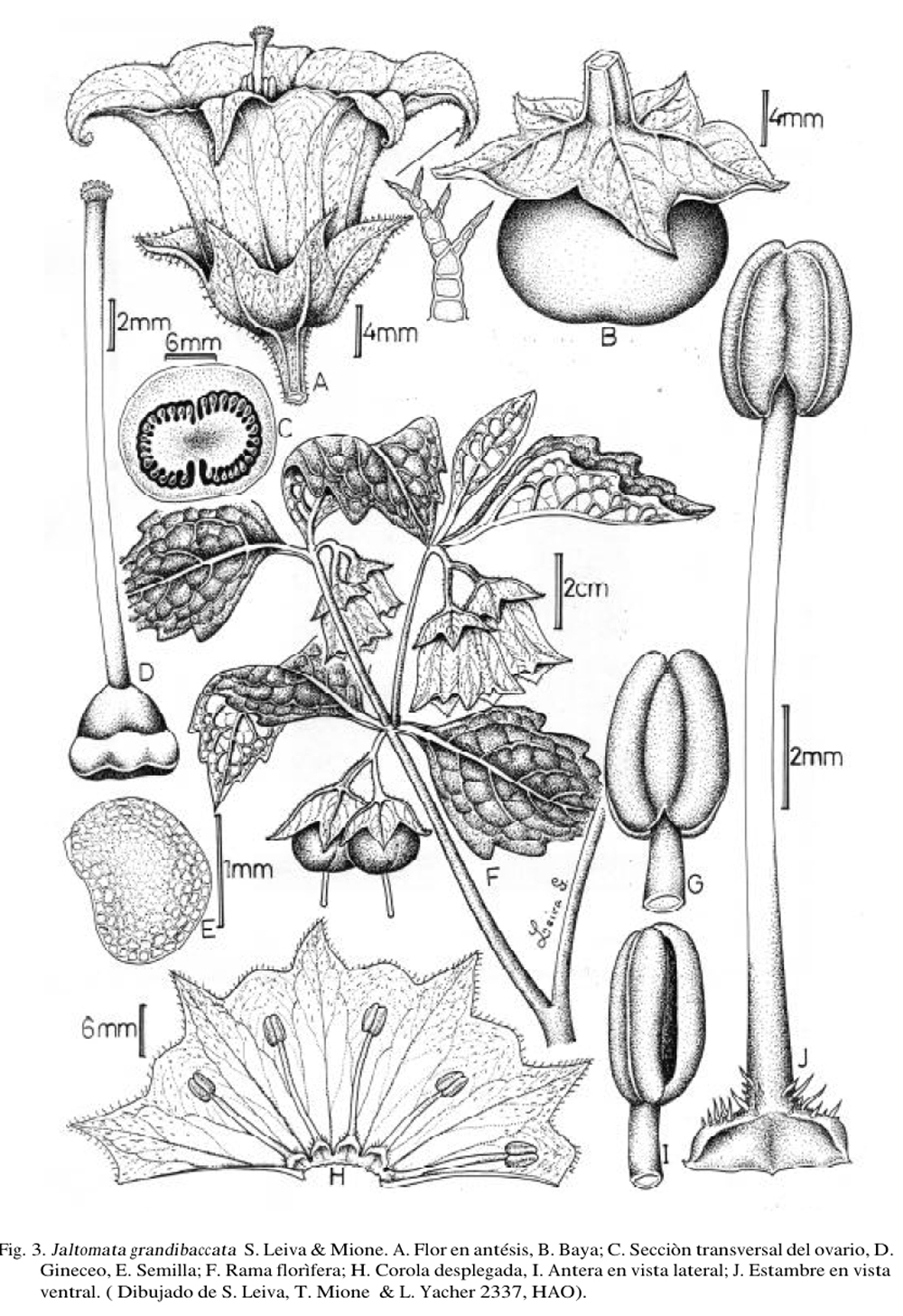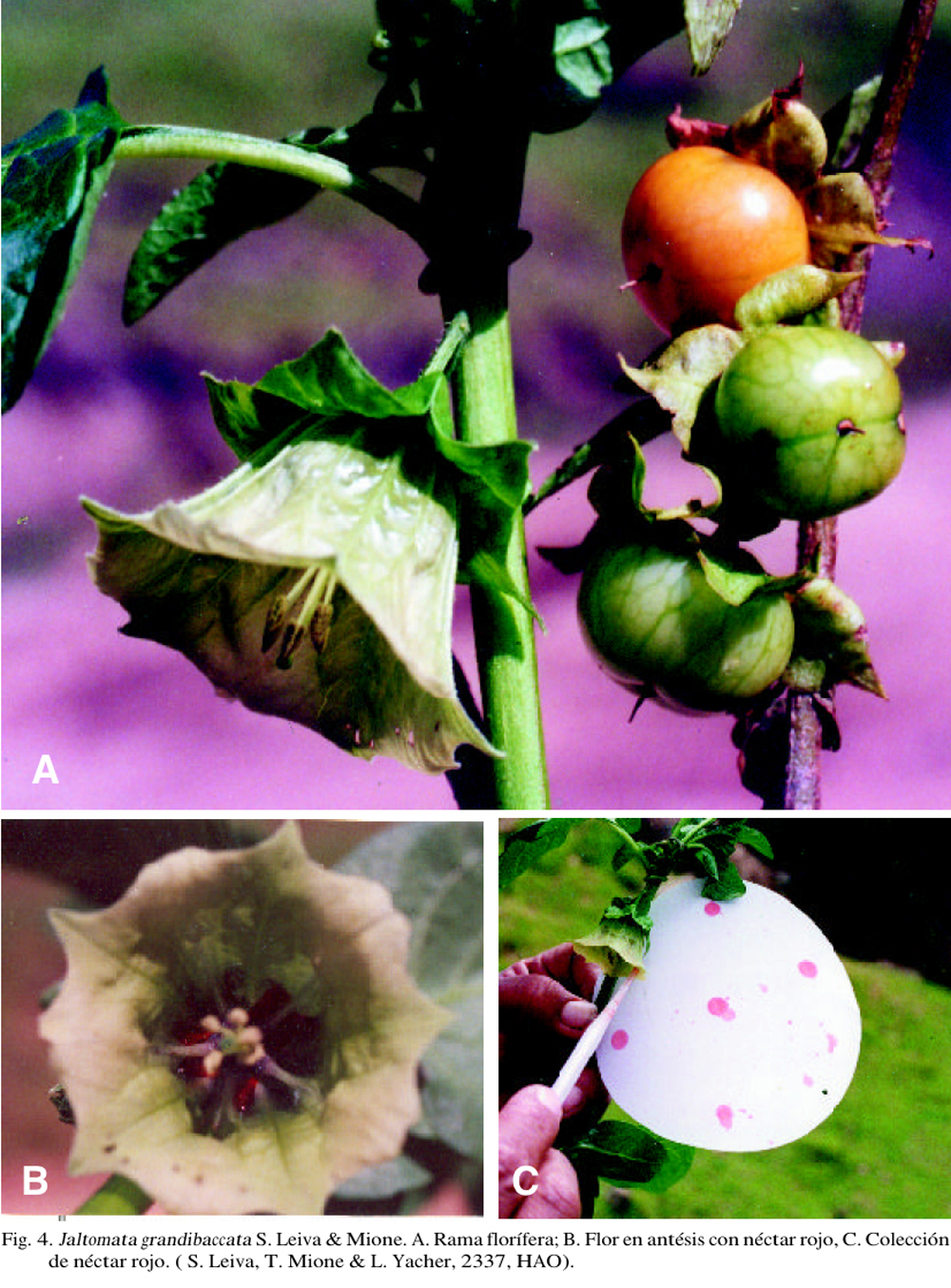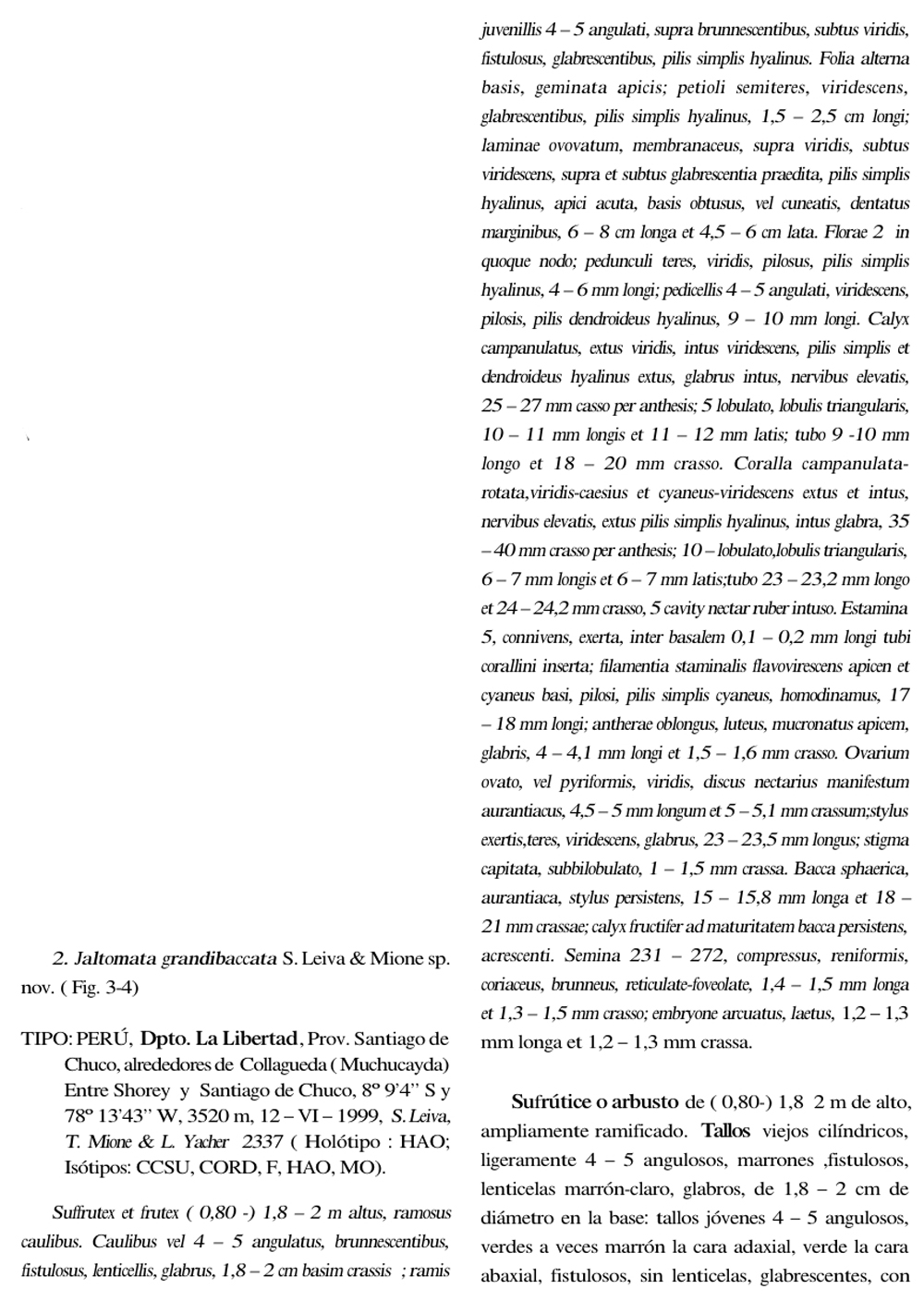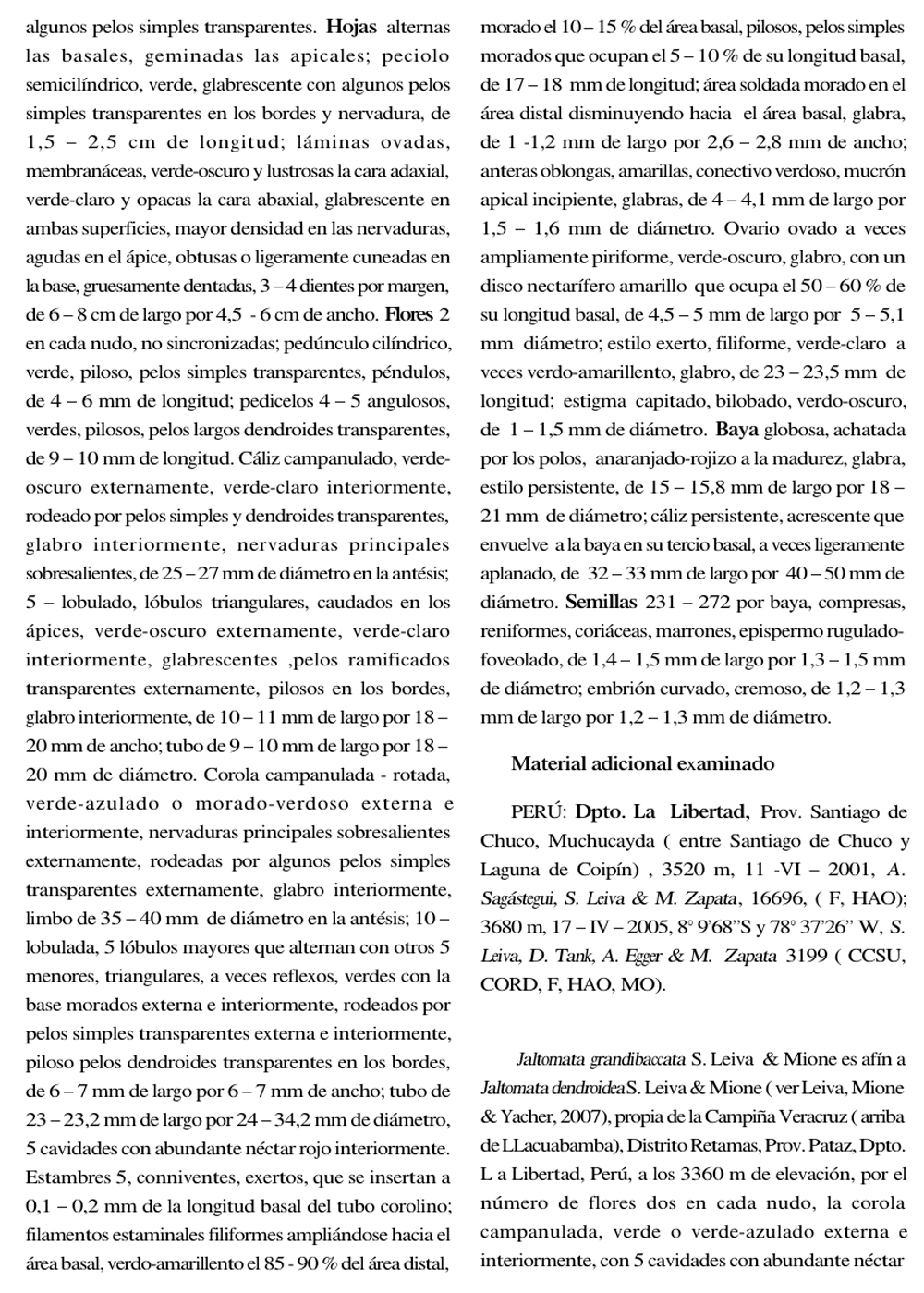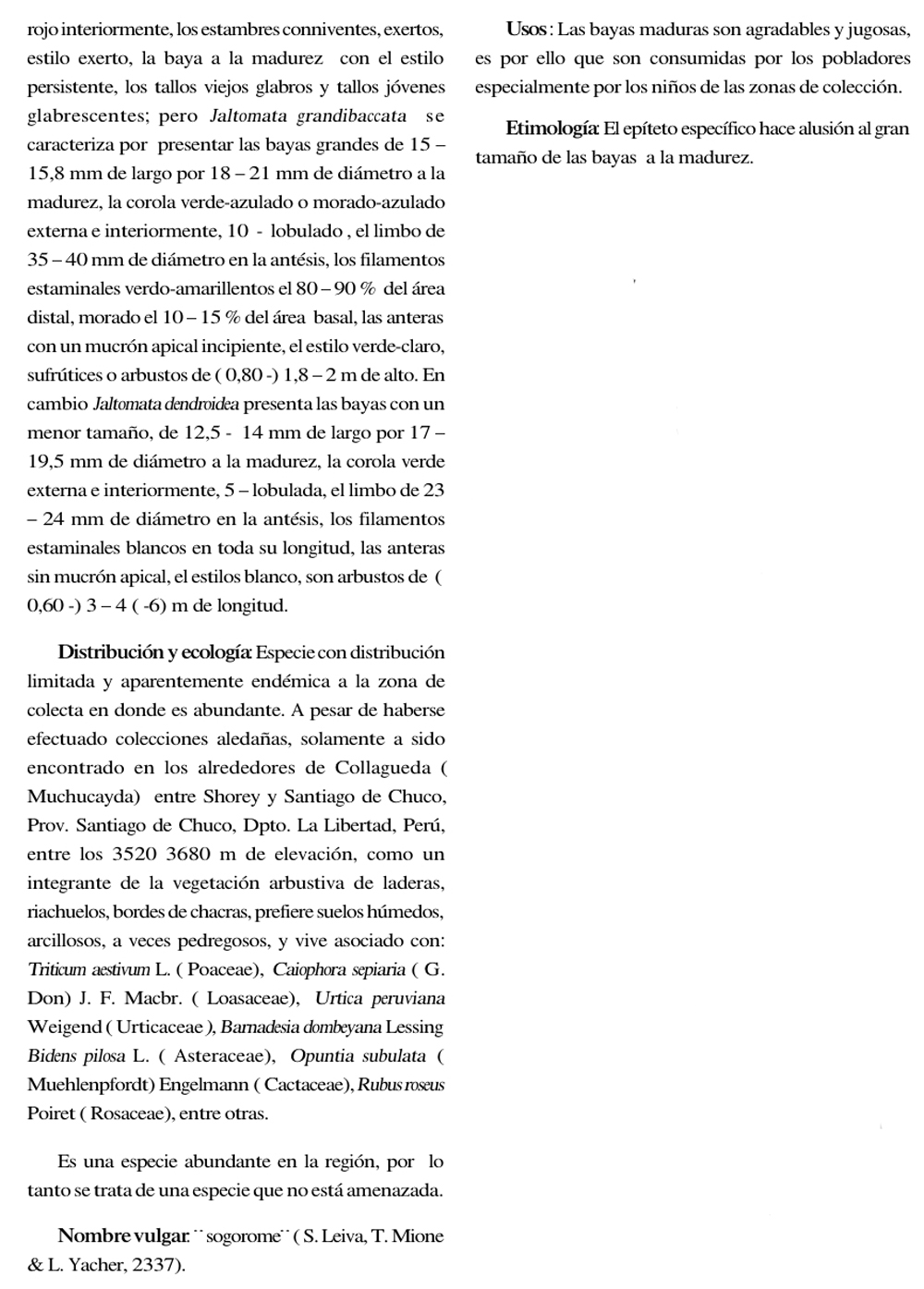Locality |
elevation |
habitat |
date |
collector |
alrededores de Collagueda ("Chollagueda" in Mione's notebook)(Muchucayda), entre Shorey y Santiago de Chuco, 8 09' 04" S,
78 13' 43" W |
3520 m |
|
12 June 1999 |
TYPE SPECIMEN OF J. grandibaccata
S. Leiva G., T. Mione & L. Yacher 2337 |
alrededores de Collagueda ("Chollagueda" in Mione's notebook)(Muchucayda), entre Shorey y Santiago de Chuco, 8 09' 04" S,
78 13' 43" W |
3530 m |
|
12 June 1999 |
Mione, S. Leiva & L. Yacher 643 collected at same time and place as type specimen of J. grandibaccata |
| 8 09.060 S,
78 13.725 W |
3682 m |
among large boulders, oca fields nearby |
23 Mar 2013 |
T. Mione, S. Leiva & L. Yacher 819
S. Leiva G., T. Mione & L. Yacher 5410 |
| |
|
|
|
|
| Las Gordas |
3490 m |
rocky treeless hillside |
12 June 1999 |
TYPE SPECIMEN OF J. guillermo-guerrae
S. Leiva, T. Mione & L. Yacher 2336 (HOLOTYPE: HAO) |
7 59 36" S,
78 22' 37" W |
3581 m |
rocky treeless hillside |
12 June 1999 |
Mione, S. Leiva & L. Yacher 642 collected at same time and place as type specimen of J. guillermo-guerrae |
| Las Gordas |
3450 m |
rocky treeless hillside |
14 June 1999 |
S. Leiva, Mione & Yacher 2348 (HAO) |
several min walk upslope from road: 7 59 34" S,
78 22' 34" W |
3549 m |
along bottom of rocky cliff |
9 June 2005 |
T. Mione, S. Leiva & L. Yacher 713 |
| Las Gordas |
3560 m |
|
8 May 2008 |
S. Leiva 4447 (HAO) [not seen by Mione, data provided by S.L.G.] |
Las Gordas, walked 2 min uphill from road:
7 59.542 S,
78 22.526 W |
3567 m |
among large boulders and closely surrounded by other vegetation |
23 Mar 2013 |
T. Mione, S. Leiva & L. Yacher 818
S. Leiva G., T. Mione & L. Yacher 5409 |
| Character |
Description of J. grandibaccata |
Description of Jaltomata guillermo-guerrae |
| |
Peru, La Libertad,
province Santiago de Chuco |
Peru, La Libertad,
province Santiago de Chuco |
| altitude of type specimen m |
3,520 |
3,490 |
| Mione et al collection numbers |
643 (collected at same time and place as type specimen), 819 |
642 (collected at same time and place as type specimen), 713, 818 |
Habit & Height |
suffrutescent or shrub, to 2 m |
shrub 0.6 - 1.3 m, much branching |
Branches, young |
4 - 5 sided, green but at times the adaxial face brown, hollow, without lenticels, glabrescent, with some simple, unpigmented hairs |
4 - 5 sided, purple to green, at times purple on upper suface and greenish on lower surface, not hollow, without lenticels, glabrous |
older |
cylindrical or somewhat 4 -5 sided, hollow, with lenticels, glabrous, to 2 cm diam |
somewhat 4 -5 sided, not hollow, with lenticels, glabrous, to 1 cm diam |
| Leaves, size |
proximally alternate, distally geminate, the blade ovate, membranous, dark green, lustrous on the adaxial (top) face, the abaxial (lower) face light-green and |
proximally alternate, distally geminate, the blade ovate, membranous, |
| shape |
|
|
| hairs |
|
|
| petiole |
semicylindrical, green, with some simple unpigmented hairs, 1.5 - 2.5 cm long |
|
Inflorescence |
2-flowered |
2-flowered |
peduncle |
cylindrical, green, pilose, the hairs simple and unpigmented, pendulous, 4 - 6 mm long |
green |
pedicel |
4-5 angled, green, pilose, the hairs dendritic, 9 - 10 mm long. |
4-5 angled, green, the hairs dendritic,
8 - 10.5 mm long |
| Calyx at flowering |
campanulate, 5 keels (where sepals meet) protruding away from the corolla (not evident on pressed specimens), the exterior dark-green, the interior light green, covered with both simple and dendritic hairs, the main vein raised, 25 - 27 mm diameter, the lobes (5) triangular |
campanulate but at times more or less flat, 5 keels (where sepals meet) protruding away from the corolla (not evident on pressed specimens), the exterior dark-green, the interior light green, glabrescent the hairs dendritic, and primarily on the principal nerves, the main vein raised, (23-) 30 - 35 mm diameter, the lobes (5) triangular |
| at fruit maturity |
37 - 42 mm (Mione's field notes) |
32 - 37 mm diam |
Corolla color |
blue-green distally,
the lobules green-blue and the lobes green |
generally blue-green, sometimes blue, the center sometimes (depending on age?) dark purple-blue fading proximal to distal to a lighter green-blue, the radial thickenings dark purple fading to blue (proximal to distal) in some of our photos |
shape and size |
campanulate, 20 mm long X 35 - 40 mm diam (lobe tip to lobe tip) measured on fresh material (not on an herbarium specimen). |
campanulate, 20 mm long X 35 - 47 mm diam (lobe tip to lobe tip) measured on fresh material (not on an herbarium specimen). |
lobes / lobules |
10 (lobes alternating with lobules) |
10 (lobes alternating with lobules) |
|
|
|
Stamen length including anther |
connivent, |
connivent, the stamens of a flower vary in length |
| length stamens exserted beyond distal end of corolla (applicable if corolla is tubular or campanulate) |
in the protologue we wrote "exertos" but when I compare the photos of 643 & 819 (grandibaccata) with those of 642 and 818 (guiermo-guerrae) I don't see a clear difference |
most photos we took in the field in Peru show stamens included, as described in the protologue, but one of my photos of Mione et al 713 shows stamens exserted a few mm |
| radial thickenings form nectar troughs |
yes
"5 cavidades llenas con abundante néctar rojo anaranjado interiormente" |
yes
"5 cavidades llenas con abundante néctar rojo anaranjado interiormente" |
| filaments |
green, the hairs at base violet-blue |
green, the hairs at the base purple |
| anther color |
yellow |
yellow, the connective green |
| anther size |
|
|
| anther mucronate / mucronultate |
no (Mione's observations on undehisced anthers with dissecting scope, 819)
"mucrón apical incipiente" (S. Leiva's observation)
|
yes (Mione's observations of undehisced anthers with dissecting scope, 642)
"sin mucrón apical" (S. Leiva's observation) |
| insertion of filament into anther |
inserting on the lower ventral face of anther |
inserting on the lower ventral face of anther |
| anthers of a flower open simultaneously? |
photos taken in Peru provide no evidence that anther dehiscence is Not simultaneous, but we may have merely photographed the flowers at a time of day after all anthers dehiseced |
photos taken in Peru provide no evidence that anther dehiscence is Not simultaneous, but we may have merely photographed the flowers at a time of day after all anthers dehiseced |
| pollen quantity per flower |
|
204,298
(n = 1 flower, count by CCSU student Elisabeth dos Santos) |
| pollen grain size |
|
|
| corona |
no |
no |
Stigma |
darker green than the style |
capitate, darker green than the style |
Style |
green, 23 - 23.5 mm long |
green, 19 - 23 mm |
Ovary |
the disk yellow |
the disk yellow-orange |
Ovules per ovary |
no data |
no data |
| Nectar |
orange-red |
red |
| Herkogamy |
yes, the stigma is exserted beyond the dehisced anthers |
yes, the stigma is exserted beyond the anthers and / or the stamens somewhat angle away (proximal to distal) positioning the dehised anthers away from the stigma |
| Protogyny |
yes (based on the presence of both open flowers having undehisced anthers and open flowers having longer stamens with dehisced anthers) |
yes (based on the presence of both open flowers having undehisced anthers and open flowers having longer stamens with dehisced anthers) |
Fruit color (at maturity) and size |
orange, 15 - 15.8 mm X 18 - 22 mm |
orange, 12 - 14 X 17 - 18 |
Seeds per fruit |
231 - 272
306 counted by T. M. in a fruit from Mione et al. 643 |
312 - 374 (protologue)
264 Mione's count |
Seed Size |
|
|
Chromosome number |
no data |
no data |
Growability in Connecticut, USA |
no data |
no data |
How long does it take from flower to ripe fruit? |
no data |
no data |
Self-Compatible? |
no data |
no data |
Seed Germination |
no data |
no data |
| Character |
Description of J. grandibaccata |
Description of Jaltomata guillermo-guerrae |
